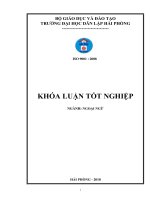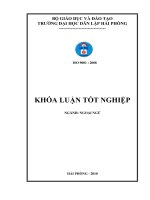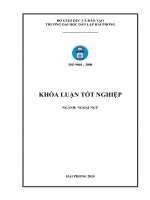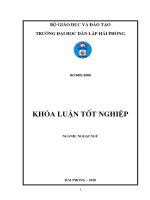A study on English varieties Some related problems facing Vietnamese learners of English and suggested solutions
Bạn đang xem bản rút gọn của tài liệu. Xem và tải ngay bản đầy đủ của tài liệu tại đây (546.25 KB, 55 trang )
1
ACKNOWLEDGEMENTS
In the process of completing this graduation paper, I have received a lot of
help, guidance as well as encouragement from lots of teachers and friends.
First of all, I would like to express my deepest thanks to Mrs. Nguyen Thi
Yen Thoa (M.A), my supervisor who have been given me helpful suggestions.
During the process of study, she has always been most willing and ready to give
me valuable advice and detailed comments on this graduation paper.
In addition, I am also graceful to other teachers in foreign language
department for their previous lectures, contribution during 4 years which help
me have ideas and knowledge to found this study.
Last but not least, I am really thankful to my family and all my friends
who always helped and encouraged me. Without their support, I could not
complete this graduation paper.
Hai Phong, July 2009
Cao Thi Hoa
2
TABLE OF CONTENTS
Acknowledgements
Abbreviations
Part one: INTRODUCTION
I. Rationale 5
II. Aims of the study 6
III. Scopes of the study 6
IV. Methods of the study 6
V. Design of the study 6
Part two: DEVELOPMENT
Chapter one: Theoretical background
I. English language 8
I.1 Geographical distribution 8
I.2 Dialects and regional varieties 9
I.3 Number of words in English 11
I.4 English as a global language 12
II. An overview of English varieties
II.1 British English 13
II.2 American English 14
II.3 Australian English 14
II.4 Canadian English 16
II.5 New Zealand English 16
III. Aspects of English varieties 17
III.1 Meaning 17
III.2 Pronunciation 18
III.3 Spelling 21
3
Chapter two: The differences between British English and American
English in word meaning
I. General Introduction about the differences between American
English and British English 23
II. Different words with the same meanings
II.1 Clothes 24
II.2 People 25
II.3 At school 26
II.4 Building and Shops 27
II.5 Sports 27
II.6 On the road 28
II.7 Others 29
III. The same words with the different meanings
III.1 Places and buildings 30
III.2 People 32
III.3 Foods and Drinks 33
III.4 Animal 34
III.5 Things 34
III.6 Natures 35
Chapter three: Some related problems facing Vietnamese learners of
English and some suggested solutions
I. Some related problems 37
II. Suggested solutions 37
III. Exercises 38
4
Part three:
I. Conclusion 41
II. References 42
Appendices:
I. Keys to exercises 43
II. Glossary 47
5
PART ONE
INTRODUCTION
I. RATIONALE
In this globalizing trend society, the need of communicating and
exchanging information, culture, technology, science and business among
countries becomes more and more necessary and to satisfy this requirement,
language as a means of communication has become increasingly important.
In English language, there are many fields in which each is studied by
different linguists. And vocabulary, which is considered a very important
branch of English language, is investigated and studied by many of
lexicologists. However, most of us often care for vocabulary and grammar while
studying English in which there are many problems for learners of English as an
international language. Among them, the varieties of native English vocabulary
cause a lot of troubles.
Varieties of English include many phenomena in both grammar and
vocabulary such as tense; complementation; preposition; words spelling,
pronunciation, meaning; … etc. These are complicate phenomena for learners of
English and they usually get troubles with this, people are always confused in
the case of English that they are communicating is different from English that
they have learnt. So it is very necessary to work in depth with this to help
learners have an over view and avoid confusing when facing it.
I hope that my study can be useful for learners of English in identifying and
understanding more about varieties of English and they can have the better result
in studying and communicating.
6
II. AIMS OF STUDY
This study aims at:
- Providing the theoretical background about English language
- Stating the different dialects.
- Discussing the varieties of English in vocabulary meaning and spelling
III. SCOPE OF STUDY
Varieties of English are a very attractive field for researchers and there are
many issues related to it, however, due to the limitation of time and knowledge,
I only study varieties of English in vocabulary. All the rest are to be left for the
further research. In this study I focus on the differences in vocabulary meaning
and spelling of American English and British English.
In daily conversation, we recognize that people often has the difficulties in
understanding or using the different words of different English dialects. The
reason is that they don‘t have much knowledge about the varieties of English
and American English and British English are most popularly used. And this
study will help people have the further view and solve their difficulties to some
extent.
IV. METHOD OF THE STUDY
To carry out this research the researcher used the following methods
- Qualitative methods are used as searching, collecting all the information,
samples from several books and websites both in English and Vietnamese, then
analyzing and systemizing them in this paper.
- Having a small comparison with the helps of native speakers.
V. DESIGN OF THE STUDY
This study is divided into three parts of which the second one is the most
important.
7
The first part named INTRODUCTION, consists of Rationale, Aims of
study, Scope of study and Design of study.
The second part titled DEVELOPMENT includes three chapters
- Chapter one: Theoretical background focuses on information of English
language
- Chapter two: The differences between American English and British
English in Vocabulary meaning
- Chapter three: : Some related problems facing Vietnamese learners of
English and some suggested solutions
The last part in this paper called CONCLUSION reviews the whole study.
8
PART TWO
DEVELOPMENT
Chapter one
THEORETICAL BACKGROUND
I. ENGLISH LANGUAGE
I.1 Geographical distribution
Approximately 375 million people speak English as their first language
English today is probably the third largest language by number of native
speakers, after Mandarin Chinese and Spanish. However, when combining
native and non-native speakers it is probably the most commonly spoken
language in the world, though possibly second to a combination of the Chinese
languages (depending on whether or not distinctions in the latter are classified as
"languages" or "dialects)". Estimates that include second language speakers vary
greatly from 470 million to over a billion depending on how literacy or mastery
is defined and measured. Linguistics professor David Crystal calculates that
non-native speakers now outnumber native speakers by a ratio of 3 to 1.
The countries with the highest populations of native English speakers are,
in descending order: United States (215 million), United Kingdom (61 million),
Canada (18.2 million), Australia (15.5 million), Ireland (3.8 million), South
Africa (3.7 million), and New Zealand (3.0-3.7 million). Countries such as
Jamaica and Nigeria also have millions of native speakers of dialect continua
ranging from an English-based creole to a more standard version of English. Of
those nations where English is spoken as a second language, India has the most
such speakers ('Indian English'). Crystal claims that, combining native and non-
native speakers, India now has more people who speak or understand English
9
than any other country in the world. Following India is the People's Republic of
China.
Pie chart showing the relative numbers
of native English speakers in the major
English-speaking countries of the
world
I.2 Dialects and regional varieties
The expansion of the British Empire and—since World War II—the
influence of the United States have spread English throughout the globe.
Because of that global spread, English has developed a host of English dialects
and English-based creole languages and pidgins.
Two educated native dialects of English have wide acceptance as standards
in much of the world—one based on educated southern British and the other
based on educated Midwestern American. The former is sometimes called BBC
(or the Queen's) English, and it may be noticeable by its preference for
"Received Pronunciation"; it typifies the Cambridge model, which is the
standard for the teaching of English to speakers of other languages in Europe,
Africa, the Indian subcontinent, and other areas influenced either by the British
Commonwealth or by a desire not to be identified with the United States. The
latter dialect, General American which is spread over most of the United States
and much of Canada, is more typically the model for the American continents
10
and areas (such as the Philippines) which have had either close association with
the United States or desire to be so identified. Aside from those two major
dialects are numerous other varieties of English, which include, in most cases,
several subvarieties, such as Cockney, Scouse and Geordie within British
English; Newfoundland English within Canadian English; and African
American Vernacular English ("Ebonics") and Southern American English
within American English. English is a pluricentric language, without a central
language authority like France's Académie française; and therefore no one
variety is considered "correct" or "incorrect" except in terms of the expectations
of the particular audience to which the language is directed.
Scots developed—largely independently
from the same origins, but
following the Acts of Union 1707 a process of language attrition began,
whereby successive generations adopted more and more features from English
causing dialectalisation. Whether it is now a separate language or a dialect of
English better described as Scottish English is in dispute. The pronunciation,
grammar and lexis of the traditional forms differ, sometimes substantially, from
other varieties of English.
Because of the wide use of English as a second language, English speakers
have many different accents, which often signal the speaker's native dialect or
language. For the more distinctive characteristics of regional accents, see
Regional accents of English, and for the more distinctive characteristics of
regional dialects, see List of dialects of the English language. Within England,
variation is now largely confined to pronunciation rather than grammar or
vocabulary. At the time of the Survey of English Dialects, grammar and
vocabulary differed across the country, but a process of lexical attrition has led
most of this variation to die out.
Just as English itself has borrowed words from many different languages
over its history, English loanwords now appear in many languages around the
11
world, indicative of the technological and cultural influence of its speakers.
Several pidgins and creole languages have been formed on an English base, such
as Jamaican Patois, Nigerian Pidgin, and Tok Pisin. There are many words in
English coined to describe forms of particular non-English languages that
contain a very high proportion of English words.
I.3 Number of words in English
The General Explanations at the beginning of the Oxford English
Dictionary states:
The Vocabulary of a widely diffused and highly cultivated living language
is not a fixed quantity circumscribed by definite limits there is absolutely no
defining line in any direction: the circle of the English language has a well-
defined centre but no discernible circumference.
The vocabulary of English is undoubtedly vast, but assigning a specific
number to its size is more a matter of definition than of calculation. Unlike other
languages, such as French, German, Spanish and Italian there is no Academy to
define officially accepted words and spellings. Neologisms are coined regularly
in medicine, science and technology and other fields, and new slang is
constantly developed. Some of these new words enter wide usage; others remain
restricted to small circles. Foreign words used in immigrant communities often
make their way into wider English usage. Archaic, dialectal, and regional words
might or might not be widely considered as "English".
The Oxford English Dictionary, 2nd edition (OED2) includes over 600,000
definitions, following a rather inclusive policy:
It embraces not only the standard language of literature and conversation,
whether current at the moment, or obsolete, or archaic, but also the main
technical vocabulary, and a large measure of dialectal usage and slang
(Supplement to the OED, 1933).
12
The editors of Webster's Third New International Dictionary, Unabridged
(475,000 main headwords) in their preface, estimate the number to be much
higher. It is estimated that about 25,000 words are added to the language each
year.
Thanks to the development of English in many ways, English vocabulary
becomes richer and richer and one of that is English varieties which will be
mentioned in the main part of this paper.
I.4 English as a global language
Because English is so widely spoken, it has often been referred to as a
"world language", the lingua franca of the modern era. While English is not an
official language in most countries, it is currently the language most often taught
as a second language around the world. Some linguists (such as David Graddol)
believe that it is no longer the exclusive cultural property of "native English
speakers", but is rather a language that is absorbing aspects of cultures
worldwide as it continues to grow. It is, by international treaty, the official
language for aerial and maritime communications. English is an official
language of the United Nations and many other international organizations,
including the International Olympic Committee.
English is the language most often studied as a foreign language in the
European Union (by 89% of schoolchildren), followed by French (32%),
German (18%), and Spanish (8%). Among non-English speaking EU countries,
a large percentage of the population claimed to be able to converse in English in
the Netherlands (87%), Sweden (85%), Denmark (83%), Luxembourg (66%),
Finland (60%), Slovenia (56%), Austria (53%), Belgium (52%), and Germany
(51%). Norway and Iceland also have a large majority of competent English-
speakers.
13
Books, magazines, and newspapers written in English are available in
many countries around the world. English is also the most commonly used
language in the sciences. In 1997, the Science Citation Index reported that 95%
of its articles were written in English, even though only half of them came from
authors in English-speaking countries
Thanks to English as a global language that many countries around the
world are using, the popularity did contribute to the development of varieties of
English.
II. AN OVERVIEW OF ENGLISH VARIETES
II.1 British English
British English, or UK English (BrE, BE, en-GB), is the broad term used
to distinguish the forms of the English language used in the United Kingdom
from forms used elsewhere. There is confusion whether the term refers to
English as spoken in the British Isles or to English as spoken in Great Britain,
though in the case of Ireland, there are further distinctions peculiar to Hiberno-
English.
There are slight regional variations in formal written English in the United
Kingdom (for example, although the words wee and little are interchangeable in
some contexts, one is more likely to see wee written by someone from northern
Britain or from Northern Ireland than by someone from Southern England or
Wales). Nevertheless, there is a meaningful degree of uniformity in written
English within the United Kingdom, and this could be described as "British
English". The forms of spoken English, however, vary considerably more than
in most other areas of the world where English is spoken
]
and a uniform concept
of "British English" is therefore more difficult to apply to the spoken language.
According to Tom McArthur in the Oxford Guide to World English (p. 45),
"[f]or many people especially in England [the phrase British English] is
tautologous," and it shares "all the ambiguities and tensions in the word British,
14
and as a result can be used and interpreted in two ways, more broadly or more
narrowly, within a range of blurring and ambiguity".
II.2 American English
American English (variously abbreviated AmE, AE, AmEng, USEng,
en-US), also known as United States English or U.S. English, is a set of
dialects of the English language used mostly in the United States.
Approximately two thirds of native speakers of English live in the United States.
English is the most common language in the United States. Though the
U.S. federal government has no official language, English is considered the de
facto language of the United States due to its widespread use. English has been
given official status by 30 of the 50 state governments.
The use of English in the United States was inherited from British
colonization. The first wave of English-speaking settlers arrived in North
America in the 17th century. During that time, there were also speakers in North
America of Spanish, French, Dutch, German, Norwegian, Swedish, Scots, Welsh,
Irish, Scottish Gaelic, Finnish, Russian (Alaska) and numerous Native American
languages.
II.3 Australian English
Australian English (AusE, AuE, AusEng, en-AU) is the form of the
English language spoken in Australia.
Australian English began diverging from British English shortly after the
foundation of the Australian penal colony of New South Wales (NSW) in 1788.
British convicts sent there, including Cockneys from London, came mostly from
large English cities. They were joined by free settlers, military personnel and
15
administrators, often with their families. However, a large part of the convict
body were Irish (at least 25% directly from Ireland, plus others indirectly via
Britain) and other non-English speaking Welsh and Scots, or at least, not from
the South/South East of Britain. English was not spoken,
or was poorly spoken,
by a large part of the convict population, and the dominant English input was
that of Cockney South-East England.
In 1827 Peter Cunningham, in his book Two Years in New South Wales,
reported that native-born white Australians of the time – known as "currency
lads and lasses" – spoke with a distinctive accent and vocabulary, with a strong
Cockney influence. The transportation of convicts to Australia ended in 1868,
but immigration of free settlers from Britain, Ireland and elsewhere continued.
The first of the Australian gold rushes, in the 1850s, began a much larger
wave of immigration, which would significantly influence the language.
Among the changes wrought by the gold rushes was "Americanisation" of
the language – the introduction of words, spellings, terms, and usages from
North American English. The words imported included some later considered to
be typically Australian, such as dirt and digger. Bonzer, which was once a
common Australian slang word meaning "great", "superb" or "beautiful", is
thought to have been a corruption of the American mining term bonanza, which
means a rich vein of gold or silver and is itself a loanword from Spanish. The
influx of American military personnel in World War II brought further
American influence; though most words were short-lived; and only okay, you
guys, and gee have persisted.
Since the 1950s American influence has mostly arrived via pop culture, the
mass media – books, magazines, television programs, and computer software –
and the world wide web. Some words, such as freeway and truck, have even
naturalised so completely that few Australians recognise their origin.
16
British words such as mobile (phone) predominate in most cases. Some
American and British variants exist side-by-side; in many cases – freeway and
motorway, for instance – regional, social and ethnic variation within Australia
typically defines word usage.
Australian English is most similar to New Zealand English due to shared
history and geographical proximity. Both use the expression different to (also
encountered in British English, but not American) as well as different from.
II.4 Canadian English
Canadian English (CanE, en-CA) is the variety of English used in
Canada. More than 26 million Canadians (85% of the population) have some
knowledge of English (2006 census). Approximately 17 million speak English
as their native language. Outside Quebec, 76% of Canadians speak English
natively. Canadian English contains elements of British English in its
vocabulary, as well as several distinctive Canadianisms. In many areas, speech
is influenced by French, and there are notable local variations. However, Canada
has very little dialect diversity compared to the United States. The phonetics,
phonology, morphology, syntax, and lexicon for most of Canada are similar to
that of the Western and Midland regions of the United States, while the
phonological system of western Canadian English is identical to that of the
Pacific Northwest of the United States, and the phonetics are similar. As such,
Canadian English and American English are sometimes grouped together as
North American English. Canadian English spelling is a blend of British and
American conventions.
II.5 New Zealand English
New Zealand English (NZE, en-NZ) is the form of the English language
used in New Zealand.









